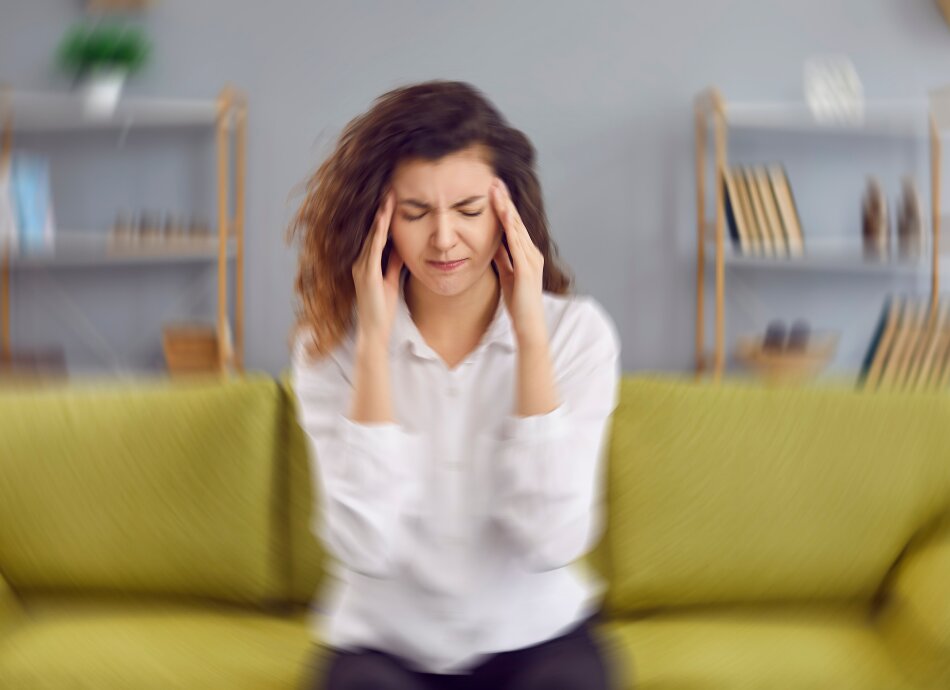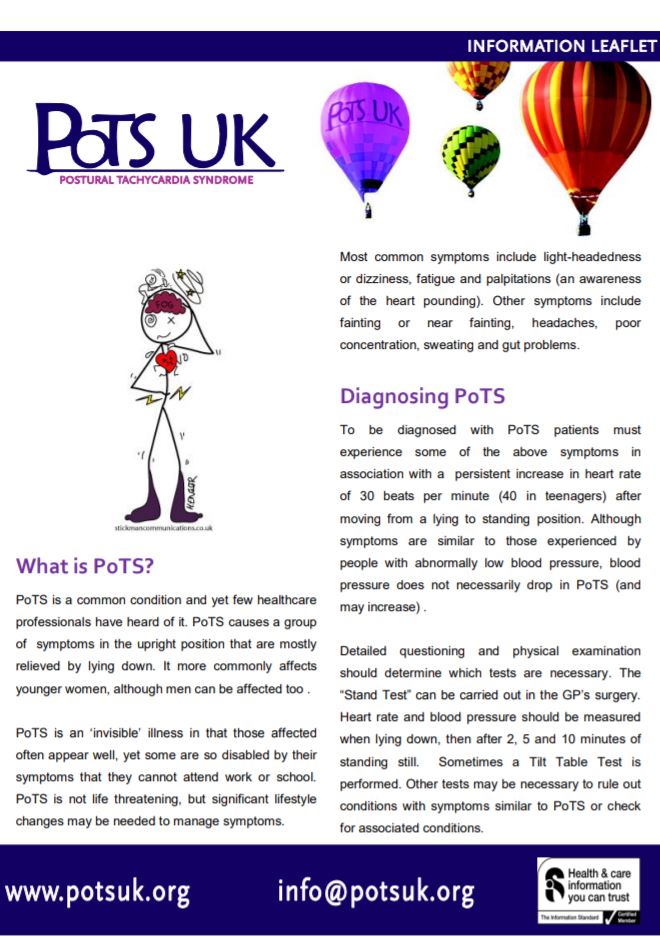Scam alert: Ads or websites claiming to have Medsafe approval or with the Medsafe logo are fake. Medsafe doesn’t endorse any health products, services or brands. Go to Medsafe for official information.
Postural orthostatic tachycardia syndrome (POTS)
Key points about POTS
- Postural orthostatic tachycardia syndrome (POTS) is a condition that causes your heart rate to increase rapidly when you sit or stand up suddenly.
- If you have POTS, your body doesn’t respond quickly enough to correct the drop in blood supply to your brain when you sit or stand up. Your heart rate increases to make up for this drop in blood pressure.
- Typical symptoms of POTS include dizziness, fainting and a racing, uncomfortable heartbeat and may be immediate or occur a few minutes later.
- Lying down, which improves blood flow to your brain usually improves symptoms.

In POTS, your autonomic nervous system (the nervous system in charge of automatic body functions) doesn’t work efficiently when you sit or stand up.
Normally when you sit up or stand, gravity pulls some blood down to your tummy area, hands and feet. This makes your blood vessels narrow quickly and your heart rate increase slightly. This keeps blood flowing to your heart and brain and stops blood pressure dropping.
However, if you have POTS, your autonomic nervous system is slow to make this correction and you have a drop in blood supply to your heart and brain when you sit or stand up. This makes your heart race to make up for this drop in blood pressure.
You can develop POTS suddenly, or it can begin gradually.
There is a range of disorders similar to POTS (a few of which involve no rise in heart rate). These fall into the category of dysautonomia, which are conditions in which the autonomic nervous system isn’t working properly.
Video: What is POTS?
This video may take a few moments to load.
(Dysautonomia International, US, 2016)
Sometimes the cause of this problem with your autonomic nervous system is not known. Sometimes it develops suddenly after a viral illness or traumatic event, or during or after pregnancy.
Other known causes are:
- hypermobile Ehlers-Danlos syndrome
- an underlying condition such as diabetes, amyloidosis, sarcoidosis, lupus, Sjögren's disease or cancer
- poisoning with alcohol or certain metals
- inheriting a gene that causes too much of the 'fight or flight' hormone noradrenaline to be produced.
People with POTS also sometimes have chronic fatigue syndrome(external link).
Even though anyone can be affected by POTS, it is most common in girls and women aged 15–50.
You may get symptoms almost immediately or a few minutes after sitting up or standing. Lying down may relieve some symptoms.
Typical symptoms of POTS include:
- heart palpitations (feeling your heart beating or racing)
- dizziness or lightheadedness
- fainting (passing out)
- problems with thinking, memory and concentration – this combination of symptoms is often called 'brain fog'
- shaking and sweating
- weakness and fatigue (tiredness)
- headaches
- poor sleep
- chest pain
- feeling nauseated (sick)
- shortness of breath
- a sense of panic.
Some people notice that feeling hot, eating a big meal, strenuous exercise, a hot shower or having a menstrual period can make their symptoms worse.
POTS may be suspected if:
- your heart rate increases by 30 beats a minute (bpm) or more, usually within 10 minutes of standing (40bpm in those aged 12 to 19)
- this continues for more than 30 seconds
- it is accompanied by other symptoms of POTS.
You may have a range of tests to confirm a diagnosis and rule out other conditions, including:
- a tilt table test – your heart rate and blood pressure are measured while you lie on a specially designed bed that can be titled upright. The measurements are taken several more times while the bed is slowly tilted into a more upright position.
- an active stand test – your heart rate and blood pressure are measured after lying down, immediately upon standing, then after 2, 5 and 10 minutes.
- an electrocardiogram (ECG) – a test of your heart's electrical activity.
- an echocardiogram – an ultrasound scan to show the structure of your heart and the blood flowing through it.
- 24-hour ambulatory blood pressure and heart rate monitoring – small devices attached to you to take regular readings while you're doing normal activities.
- blood tests – to test your iron, kidney, liver and thyroid function, and measure blood count and your calcium and glucose levels.
Tests are most often carried out by cardiologists and neurologists.
The self-care measures described below can sometimes help to reduce the symptoms of POTS. If these do not work, you may need to take medicine. The important thing is to understand the issue and not panic.
There are 3 main approaches to treating POTS: treating an episode, taking preventative steps to reduce your symptoms and taking medication.
Treating an episode
If you suddenly feel faint or dizzy, try to counter the fall in blood flow by:
- lying down and, if you can, raising your legs
- crossing your legs in front of each other while standing
- rocking up and down on your toes
- clenching your buttocks and tummy muscles
- clenching your fists if you can’t lie down.
Taking steps to prevent symptoms developing
You may be able to reduce your symptoms in the long term if you:
- drink plenty of fluids until your pee is pale yellow
- keep active, but pace yourself and choose your exercise carefully – swimming, rowing, lower limb resistance training, walking, jogging and Pilates can help you keep fit and build muscle (strong calf muscles should help pump blood back to your heart)
- raise the head end of your bed, so you're not sleeping fully flat
- try wearing support tights or other forms of compression clothing, to improve blood flow in your legs
- avoid long periods of standing, particularly in the heat
- avoid long, hot showers
- cross your legs and draw up your knees if sitting for long periods of time
- get up slowly after lying down and sit for a while before standing
- avoid drinking lots of caffeine or alcohol
- add more salt to your diet through the day (provided you don’t have high blood pressure or kidney or heart disease)
- use electrolyte drinks in hot weather or before sport, when you may sweat a lot.
Taking medicine
There's currently no medicine licensed for the treatment of POTS, but your specialist might suggest trying a medicine ‘off label’, such as:
- a beta-blocker – which decreases heart rate
- midodrine – which narrows blood vessels
- fludrocortisone – which helps your kidneys retain sodium
- a selective serotonin reuptake inhibitor (SSRI) – a type of antidepressant that can affect how your nervous system works.
If a medicine is used off label, it has not gone through clinical trials for it to be used in this way, but many experts believe it's likely to be effective. Your doctor can discuss the possible benefits and risks with you.
Apps reviewed by Healthify
You may find it useful to look at some Pain management apps, Migraine and headache apps and Sleep apps.
While there is currently no absolute cure for POTS, most people find that with changes to your lifestyle such as exercise and diet, and medical treatment, it improves gradually over time.
If an underlying cause can be identified, and if that cause is treatable, POTS symptoms are likely to reduce.
While the prognosis is good for most people, for some people symptoms won’t improve and may occasionally worsen over time.
Complex Chronic Illness Support(external link) Phone 07 281 1481. Information, support and practical advice for people, families and carers affected by POTS.
Orthostatic intolerance and its treatment(external link) Peter C. Rowe, Chronic Fatigue Clinic, Johns Hopkins Children’s Center, US, 2014
POTS UK(external link) Information and support for those living with POTS
POTS explained by doctors and patients(external link) MyHeart.net, US
Postural orthostatic tachycardia syndrome (POTS)(external link) WebMD, US
Postural tachycardia syndrome(external link) POTS, UK, 2020
What is PoTS? (external link)POTS, UK, 2018
Apps
Pain management apps
Migraine and headache apps
Sleep apps
References
- Postural tachycardia syndrome (POTS)(external link) NHS, UK
- Postural orthostatic tachycardia syndrome(external link) Dysautonomia International
- Postural orthostatic tachycardia syndrome(external link) Genetic and Rare Disease Information Center, National Institutes of Health, US
- GP guide to POTS(external link) POTS UK
- Kizilbash SJ, Ahrens SP, Bruce BK et al. Adolescent fatigue, POTS, and recovery – a guide for clinicians(external link) Current Problems in Pediatric and Adolescent Health Care. 2014 May–Jun; 44(5): 108-133.
- Raj SR. Postural tachycardia syndrome (POTS)(external link) Circulation. 2013 Jun 11; 127(23): 2336–2342.
- Benarroch EE. Postural tachycardia syndrome – a heterogeneous and multifactorial disorder(external link) Mayo clinic Proceedings. 2012 Dec; 87(12): 1214–1225.
- Rowe PC. Orthostatic intolerance and its treatment(external link) Chronic Fatigue Clinic, Johns Hopkins Children’s Center, US, 2014
Apps
Brochures

POTS, UK, 2020

POTS, UK, 2018
Credits: Healthify editorial team. Healthify is brought to you by Health Navigator Charitable Trust.
Reviewed by: Dr Rosemary Vallings, Auckland
Last reviewed:
Page last updated:





